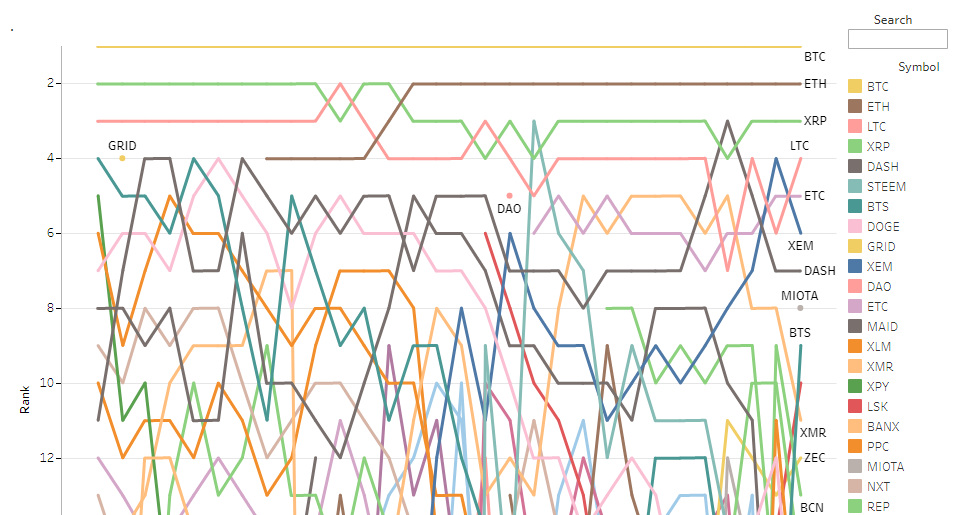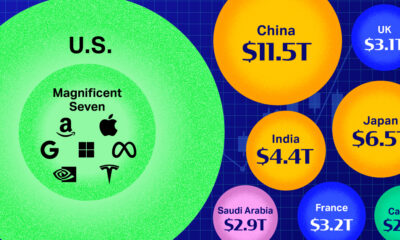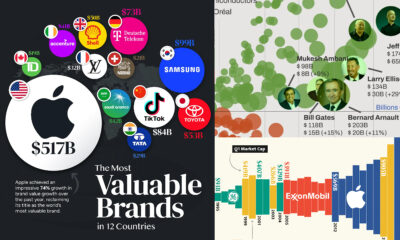Technology
Interactive: Ranking the 20 Most Valuable Cryptocurrencies Over Time
The following interactive visualization sorts and ranks all cryptocurrencies by market capitalization.
var divElement = document.getElementById(‘viz1498757488102’); var vizElement = divElement.getElementsByTagName(‘object’)[0]; vizElement.style.width=’1004px’;vizElement.style.height=’869px’; var scriptElement = document.createElement(‘script’); scriptElement.src = ‘https://public.tableau.com/javascripts/api/viz_v1.js’; vizElement.parentNode.insertBefore(scriptElement, vizElement);
Ranking the 20 Most Valuable Cryptocurrencies Over Time
Many cryptocurrencies have followed Bitcoin, but none have been able to crack its dominance of the digital currency marketplace. The above interactive graphic, by CryptoReach, shows the top 20 cryptocurrencies ranked by market capitalization over the course of the past 2.5 years.
This ranking can teach us about the evolving market for cryptocurrencies and the direction it may take as more and more competing players emerge.
A Matter of Scale
The movement – or lack thereof – of market cap rankings as shown in the chart can be deceiving at first.
Keep in mind that the rankings, as listed, don’t take the scale of differences in market cap (or coin price) into account. The ever-increasing valuation of Bitcoin is a great example of this. With a market cap recently reaching $40 billion, it surpasses most other cryptocurrencies on the list by an order of magnitude despite only being separated from them by a few ranking points.
Cryptocurrencies Grow Across the Board
Just because a particular currency falls down the rankings doesn’t necessarily mean that its market cap is shrinking: it may simply not be keeping up with the growth of its peers. Dashcoin, for example, fell four ranking points between March and May of the past year despite nearly $200 million of growth in value.
This simply reflects a much broader overall trend: the extraordinary speed at which the cryptocurrency market as a whole is growing in value – that is, until the recent pullback in the last month.
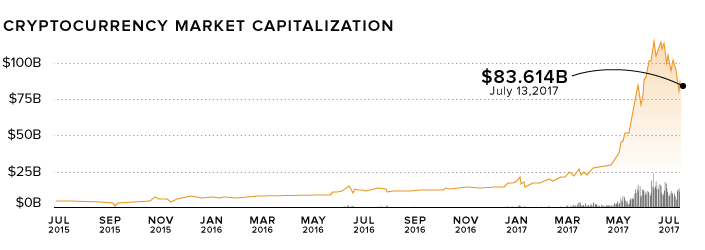
Some mainstream analysts have characterized the rapidly rising valuations of cryptocurrencies in the past several months with words like “insane”, stoking fears of a bubble set to burst. So far that hasn’t happened yet, but it is true that the coin universe has had a significant pullback after powering through $100 billion in value in June 2017.
For anyone that follows the crypto market, they know that such volatility isn’t unusual. Bitcoin has often been either best or worst performing currency in back-to-back years through its short history.
But despite this aforementioned volatility in the market, the coin universe has evolved over time to include many other cryptocurrencies. With the market assigning strong valuations to many different coins, it confirms broad interest in the sector and blockchain as a whole, while helping alleviate some signs of a “bubble about to burst”.
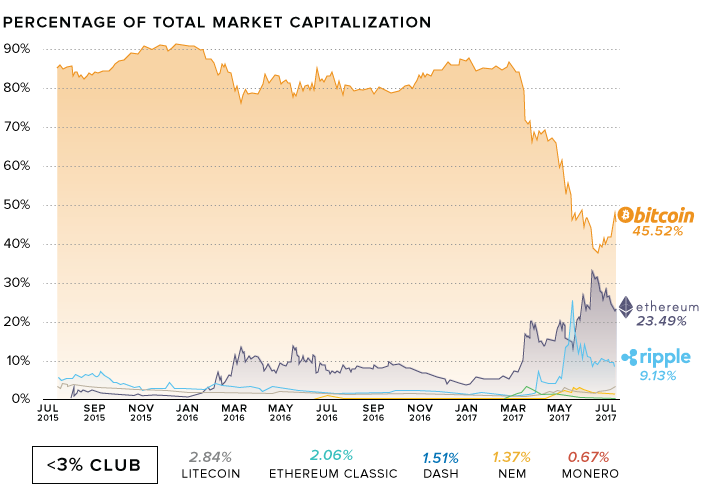
Rise of the Disruptors
As we can see in the above graphics and the interactive chart, Bitcoin has dominated the list of highest-valued cryptocurrency players for close to three years. However, other currencies have recently entered the mainstream, preventing Bitcoin from owning the entire market.
The appearance of the more technologically advanced currency Ethereum on the market in mid-2015 appears to have challenged for Bitcoin’s share of the market, as well as ending the ongoing battle for the second-place ranking between Ripple and Litecoin. In the short span between December 2015 and February 2016 (when it overtook Ripple for the #2 rank,) Ethereum’s market cap grew nearly eight-fold.
Technology
All of the Grants Given by the U.S. CHIPS Act
Intel, TSMC, and more have received billions in subsidies from the U.S. CHIPS Act in 2024.

All of the Grants Given by the U.S. CHIPS Act
This was originally posted on our Voronoi app. Download the app for free on iOS or Android and discover incredible data-driven charts from a variety of trusted sources.
This visualization shows which companies are receiving grants from the U.S. CHIPS Act, as of April 25, 2024. The CHIPS Act is a federal statute signed into law by President Joe Biden that authorizes $280 billion in new funding to boost domestic research and manufacturing of semiconductors.
The grant amounts visualized in this graphic are intended to accelerate the production of semiconductor fabrication plants (fabs) across the United States.
Data and Company Highlights
The figures we used to create this graphic were collected from a variety of public news sources. The Semiconductor Industry Association (SIA) also maintains a tracker for CHIPS Act recipients, though at the time of writing it does not have the latest details for Micron.
| Company | Federal Grant Amount | Anticipated Investment From Company |
|---|---|---|
| 🇺🇸 Intel | $8,500,000,000 | $100,000,000,000 |
| 🇹🇼 TSMC | $6,600,000,000 | $65,000,000,000 |
| 🇰🇷 Samsung | $6,400,000,000 | $45,000,000,000 |
| 🇺🇸 Micron | $6,100,000,000 | $50,000,000,000 |
| 🇺🇸 GlobalFoundries | $1,500,000,000 | $12,000,000,000 |
| 🇺🇸 Microchip | $162,000,000 | N/A |
| 🇬🇧 BAE Systems | $35,000,000 | N/A |
BAE Systems was not included in the graphic due to size limitations
Intel’s Massive Plans
Intel is receiving the largest share of the pie, with $8.5 billion in grants (plus an additional $11 billion in government loans). This grant accounts for 22% of the CHIPS Act’s total subsidies for chip production.
From Intel’s side, the company is expected to invest $100 billion to construct new fabs in Arizona and Ohio, while modernizing and/or expanding existing fabs in Oregon and New Mexico. Intel could also claim another $25 billion in credits through the U.S. Treasury Department’s Investment Tax Credit.
TSMC Expands its U.S. Presence
TSMC, the world’s largest semiconductor foundry company, is receiving a hefty $6.6 billion to construct a new chip plant with three fabs in Arizona. The Taiwanese chipmaker is expected to invest $65 billion into the project.
The plant’s first fab will be up and running in the first half of 2025, leveraging 4 nm (nanometer) technology. According to TrendForce, the other fabs will produce chips on more advanced 3 nm and 2 nm processes.
The Latest Grant Goes to Micron
Micron, the only U.S.-based manufacturer of memory chips, is set to receive $6.1 billion in grants to support its plans of investing $50 billion through 2030. This investment will be used to construct new fabs in Idaho and New York.
-

 Brands6 days ago
Brands6 days agoHow Tech Logos Have Evolved Over Time
-

 Economy2 weeks ago
Economy2 weeks agoWhere U.S. Inflation Hit the Hardest in March 2024
-

 Green2 weeks ago
Green2 weeks agoTop Countries By Forest Growth Since 2001
-

 United States2 weeks ago
United States2 weeks agoRanked: The Largest U.S. Corporations by Number of Employees
-

 Maps2 weeks ago
Maps2 weeks agoThe Largest Earthquakes in the New York Area (1970-2024)
-

 Green2 weeks ago
Green2 weeks agoRanked: The Countries With the Most Air Pollution in 2023
-

 Green2 weeks ago
Green2 weeks agoRanking the Top 15 Countries by Carbon Tax Revenue
-

 Markets2 weeks ago
Markets2 weeks agoU.S. Debt Interest Payments Reach $1 Trillion


